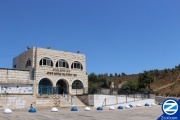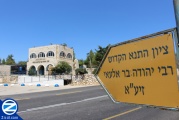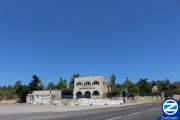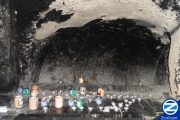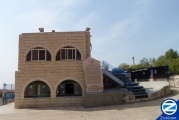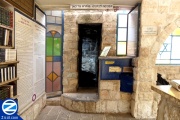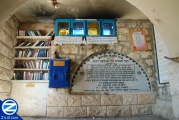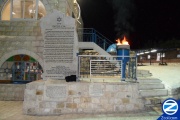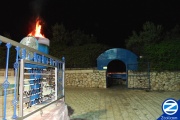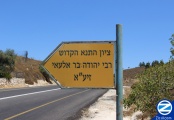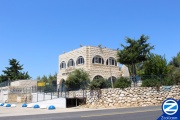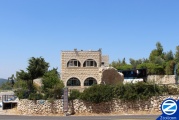Rabbi Yehuda bar Ilai
Rabbi Yehuda bar Ilai was a fourth generation Tana and is the most frequently mentioned Sage in the Mishnah, where he is referred to simply as Rebbe Yehuda. A student of Rebbe Akiva, he was also one of the five student ordained by Rebbe Yehuda ben Baba as he sacrificed his life. Rebbe Yehudah bar Ilai lived a most of his life in complete poverty. As a result of the same incident that sent Rebbe Shimon bar Yochi into hiding, Rabbi Yehuda was appointed by the Romans as the initiating speaker at all Rabbinic gatherings, for having praised them. He is buried in Ein Zetim and many people visit his kever as segula for parnasa.
Contents |
[edit] Life
Rabbi Yehuda was born in the city of Usha, in the lower Galilee, east of Chaifa to the Tana Rabbi Ilai whose family originated from Bavel.
[edit] Gathering of Usha
After the death of Hadrian and the easing of the Roman decrees the leading Sages of Israel gathered in Usha to reconvene. Extra honor was given to Rabbi Yehuda bar Ilai since he was native resident of the city.
[edit] Head Speaker
[edit] Personality
[edit] Poverty
Rabbi Yehuda bar Ilai lived his life in poverty. His students were also poor and sometimes, six of them had to share one covering to keep themselves warm as they studied Torah. So poor was Rebbe Yehuda that when his wife finally was able to buy material and sew a coat, they both had to share it, each leaving the home at different times. When Rabbi Yehuda bar Ilai would put on the coat he would make a blessing; 'Baruch ShAsani Meil' - 'Blessed is Hashem for giving me a coat', a blessing that he innovated due to his gratitude for owning a coat.
Once, the Nasi Rabban Shimon ben Gamliel decreed a day of prayer and fasting. Rabbi Yehuda was unable to attend the gathering since he had no robe to wear at the time. Rabban Shimon ben Gamliel sent him a robe as a gift but Rabbi Yehuda refused to take it. Instead he lifted the mat upon which he sat and showed the messenger how underneath it lay many golden coins. He then said "See how much wealth I have but I do not wish to make use of it in This World". Although the appearance of the gold coins under his mat was a miracle, Rabbi Yehuda bar Ilai was showing that if he desired money he could easily get it.
[edit] Chasid
Whenever a tale is given in the Talmud about a Chasid (extremely righteous individual) without giving his name, it is referring to either Rabbi Yehuda bar Ilai or Rabbi Yehuda be Bava.
Bringer of Peace
A man once got angry at his wife for burning his food. He made a vow disassociating her unless she got Rebbe Yehuda and Rebbe Shimon to eat the dish. Rebbe Yehuda agreed to taste the dish despite the humiliation, saying he was no better then the Hashem who was willing to have his name erased in the waters of the Sotah to bring peace between husband and wife. Rebbe Shimon on the other hand refused, in order to uphold the respect the Sages and so people would abstain from making vows.
Honoring the Shabbot
Once Rabbi Yehuda bar Ilai noticed a breach in the fence of his vineyard as he walked through it on Shabbos, causing him to speculate fixing it during the week. Immediately he regretted thinking about mundane actions on the Shabbos and committed to never patch the hole, as a punishment for what was considered a transgression on his high level. His actions found favor in the eyes of Hashem who caused a Tzlaf tree to grow in that very location, filling up the breach and at the same time supplying a livelihood to Rabbi Yehuda for the remainder of his life. It was during this incident that Rebbe Yehuda performed one of the final rectifications for the sin of Tzlafchad, who's spirit had become impregnated within him at the time of this test.
[edit] Shining Face
Rabbi Yehuda bar Ilai used to have an aura of light emanating from his face, a constant glow of happiness. Once he was accused by an early Christan of either being an alcoholic or alternatively earning an easy, consistent, stress-less and lucrative livelihood through lending money with interest or by raising pigs, thinking one of these to be the source his facial radiance. Rabbi Yehuda replied that he could hardly drink the wine mandated by Halacha, let alone be an alcoholic and would definitely not desecrate the Torah by lending with interest or raising pigs. Rather on his way to study Torah he would pass by 24 restrooms, checking himself by each one.
A different time Rebbe Yehuda was accused by a Roman noblewoman of being drunk while issuing Halachic rulings, due to the radiance of his face. He replied the source of his aura was from the Torah he studied as it says "the wisdom of a man will enlighten his face".
[edit] Erev Shabbos
Each Friday, his students would bring Rebbe Yehuda a large basin of hot water. He would then rinse his face, hands and feet and wrap himself in sheets that had Tzitzis on their edges. Upon absorbing the holy energy of Shabbos, Rebbe Yehuda would gain the appearance of a G-dly angel.
[edit] No Wine
It was very hard for Rabbi Yehuda bar Illai to drink wine and he would force himself to drink the Kidush and four cups of wine during the Pesach Seder. After Peasach Rabbi Yehuda would have to wrap a bandage around his head for 7 weeks until Shevuot, due to the resulting pain.
[edit] Tisha Bav
Living only a generation after the destruction of the Second Temple, Rabbi Yehuda bar Ilai fully comprehended this significant loss, greatly mourning this tragedy and helped form the tradition of the 'Seudat Mafseket'. On the evening proceeding the 9th of Av his students would bring Rabbi Yehuda a 'Seudat Hamafseket' - 'Separation Meal' composed of only dry bread and salt. He would then sit down in the lowest place of his house, between the oven and the stove, eat the bread and drink water and appear as if a very close dead relative was laying before him.
[edit] Dancing Before Kalla
At weddings, Rabbi Yehuda bar Illai would hold a myrtle branch in his hand and dance in-front of the bride. This custom attested to his high level of Shmiras Habris, showing that he was completely unafraid of it effecting him.
[edit] Tana
Rabbi Yehuda bar Ilai is the most commonly mentioned Tana in the Mishna, Safra and Tosefta where he is simply called 'Rebbe Yehuda'. He is mentioned in over 600 Mishnayos, often multiple times in each, almost double the amount of any other Tana. Any time Rebbe Yehuda argues with Rebbe Meir or Rebbe Shimon, the Halacha is established in his favor. All anonymous teachings in the Safra are from Rabbi Yehuda as he received the teachings for Rabbi Akiva.
[edit] Family
Rabbi Yehuda's father was the Tana Rabbi Illai. His son was the Tana Rabbi Yossi bar Yehuda.
[edit] Teachers
Rabbi Yehuda bar Ilai's main teachers were Rabbi Akiva and Rabbi Tarfon. In his youth he studied under his father who passed down to him the Torah of his master Rebbe Eliezer ben Hurkanes. Rabbi Yehuda also studied somewhat under all the Sages of Yavneh including; Rebbe Eliezer ben Hurkanes, Rabbi Elazar ben Azariah, Rabban Gamliel, Rabbi Yehoshua ben Chananya, Rabbi Yossi Haglili, Rabbi Yishmoel and Abba Tzydon, later passing down some of their teachings.
[edit] Rabbi Tarfon
Rabbi Yehuda was a student of Rabbi Tarfon since his youth and served him for a few years. There are a number of stories in the Talmud about their relationship. Rabbi Tarfon liked his student even calling him at some points 'my son' and presenting him a stick that he used as a Cohen in the purification ritual of three leapers.
Once Yehuda bar Nechenia triumphed over Rabbi Tarfon as he delivered his discourse and his face glowed with pride. Rabbi Akiva who saw this lack of respect for the great elder Rabbi Tarfon, exclaimed his doubts about Yehuda bar Nechenia living much longer. Rabbi Yehuda bar Ilai who witnessed this event came back a few months later during Shevuot and inquired about Yehuda bar Nechenia to find out the outcome of this incident, and sure enough he had died.
[edit] Rabbi Akiva
After the passing of his 24,000 students, Rabbi Akiva gathered Rabbi Meir, Rabbi Yehuda, Rabbi Shimon, Rabbi Yossi and Rabbi Elazer ben Shmua who were spreading Torah in Southern Israel as the time. He then placed all his energy to transmit his Torah to these 5 Sages, who then revived and saved the Torah from becoming extinct in Eretz Yisroel due to the harsh Roman decrees.
[edit] Rabbi Yehuda ben Bava
[edit] Friends
Friends of Rabbi Yehuda bar Ilai included Rabbi Shimon bar Yochi, Rabbi Yossi ben Chalafta and Rabbi Meir.
[edit] Students
Students of Rabbi Yehuda bar Ilai included Rabbi Elazar son of Rabbi Shimon bar Yochi, Rabbi Yishmoel son of Rabbi Yossi ben Chalafta and Rabbi Yehuda Hanasi.
[edit] Teachings
[edit] Torah and Livelihood
Avoid Laxity While Studying
Be cautious with your learning and study with depth and detail since a lack of depth during learning can lead you to accidentally issue false Halachic rulings which will then be considered as if it was done maliciously. (Masechet Avos)
Make Torah Superior to Work
A person that makes his Torah study the center of his life and his livelihood secondary, in Heaven they make him central in This World. However a person that makes his livelihood the center of his life and Torah study secondary, in Heaven they make him unimportant in This World. (Avos D'Rebbe Nasson 28)
Teach Children a Trade
Any person that does not teach his son a trade, automatically teaches him theft. (Talmud Kidushin 29A)
The Early Generations
What is the difference between the early and the later generations? The early generations made their Torah central and their work secondary, therefore both remained firm in their hands. However the later generations made their work central and Torah secondary, therefore neither lasted in their hands. (Talmud Brachos 35B)
[edit] Yetzer Hara
In the future Hashem will bring each person's evil inclination and slaughter it before him. Righteous people will see their Yetzer Hara as a huge mountain and will cry from delight that they were able to overcome it. Evil people will visualize their Yetzer Hara as hair-thin thread and will cry out of anguish that they were dominated by such a minor thing. (Talmud Sukah 52A)
[edit] Nation of Yisroel
The Nation of Yisroel is compared to both stars and dust in the Torah. When they fall, they descend as low as the dust but when they rise they rise as high as the stars. (Talmud Migila 16A)
[edit] Kever Rabbi Yehuda bar Ilai
Rabbi Yehuda bar Ilai is buried in a cave located in Ein Zeitim, Northern Israel, around 3 kilometers Northwest of Safed. Above the cave a Beis Medrash was built, which contains stairs leading down to the cave. Rabbi Yehuda bar Ilai is buried on the left side of the cave and his students or family are buried on the right side. A separate women's section contains a Tzion which was the outside of the original structure built over the cave.
Historically this tomb was often visited by the Kabbalists of Tzfat who would frequent the Kever on Erev Rosh Chodesh. Rabbi Yossi Saragossi would often visit the Kever and then do Hisbodedute amongst the olive trees of the adjacent field. It was here that he had a revelation of Eliyahu the Prophet and therefore asked to be buried there upon his passing. Kever Rabbi Yehuda bar Ilai was also revered by the local Arabs who would light candles in his honor.
Rabbi Yehuda's father Rabbi Ilai is buried in a nearby cave across the road. In the vicinity are the Kivarim of Rabbi Cruspedi the Tana, Rabbi Yossi Saragossi, Rabbi Yochanan ben Baroka and possibly Rabbi Yitzchak HaLavan.
[edit] Burial of Jewish Human Soap
After the Holocaust, part of the human soap created from the body fat of Jews by the accursed Nazis was recovered and was brought to burial inside the cave.
[edit] Hillulah of Rabbi Yehuda bar Ilai
The Yortzite of Rebbe Yehuda bar Illai is celebrated on the 14th of Iyyar, Pesach Shani. Although the exact date of the hillula is unknown, this date was chosen due to its proximity to Lag Baomer when many pilgrims traveled up North each year for the Hillula of the Rashbi. This is the same date chosen for the Hillula of the Tana Rebbe Meir.
[edit] Segulah for Parnasa
Many people consider Kever Rebbe Yehuda bar Illoy an auspicious place to pray about livelihood. There are a number of Segulot dependent on the location.
[edit] Directions
Geographic Coordinates
- Latitude: 32.984593
- Longitude: 35.490523
[edit] More Photos
- Kever Rabbi Yehuda bar Ilai Photo Gallery



